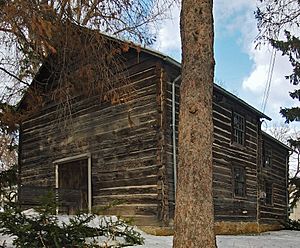Muskego Settlement, Wisconsin facts for kids

The Muskego Settlement was one of the very first places where Norwegian-American people settled in the United States. It was located near what is now Muskego, Wisconsin. This settlement covered parts of what is known today as the town of Norway in Racine County, Wisconsin.
Contents
How the Muskego Settlement Began
The Muskego Settlement was started in 1839. A man named John Nielsen Luraas (1813–1890) led the first group of settlers. Most of these early immigrants came from a part of Norway called Telemark.
They were encouraged to come to Wisconsin by two brothers, Ansten and Ole Knudsen Nattestad. These brothers had moved from Norway in 1838. They had already started the first Norwegian-American community in Wisconsin at Jefferson Prairie Settlement in Rock County.
The first group of settlers claimed about 640 acres (2.6 square kilometers) of land in Waukesha County. The next year, two more settlers, Søren Tollefsen Bache (1814–1890) and Johannes Johannsen, settled nearby. Their land was in Racine County, just south of the first settlement. This area is now the town of Norway, Wisconsin. Because of this, the Muskego Settlement ended up stretching across the border between two counties.
Important People and Events
Johannes Johannsen and Søren Bache were very important to the Muskego Settlement. Johannes Johannsen wrote something called the Muskego Manifesto in 1845. This was an open letter from the settlers to the people back in Norway. It was written to answer the Norwegian government, which was trying to stop people from leaving Norway. The Muskego Manifesto was printed in a Norwegian newspaper on April 1, 1845. Sadly, Johansen died less than a year after writing it.
Søren Bache stayed important in Muskego for several years. He helped start Nordlyset, which was the first newspaper in the United States written in the Norwegian language. He also wrote a detailed diary about his experiences as a pioneer. Søren Bache went back to Norway in 1847 and lived there until he died in 1890.
A Welcoming Home for Immigrants
Even Hansen Heg (1790–1850) was another important immigrant who arrived soon after. In Norway, he had owned a hotel. In Muskego, Even Heg created a kind of welcome center for new immigrants.
In 1843, Heg built a large barn in Muskego. This barn became the first home in America for many Norwegian immigrants. It also served as a social and religious meeting place for the community.
Early Church and Community Leaders
Claus Lauritz Clausen arrived in 1843. He became the pastor for the Muskego settlement. He helped create the first Norwegian Lutheran Church in America congregation in the area. This church followed the traditions of the state church in Norway. Clausen also helped organize and lead several other Lutheran churches nearby.
Elling Eielsen had moved to the United States in 1839. He first visited Muskego before moving to the Jefferson Prairie Settlement. Eielsen was a Lutheran pastor from 1846 to 1872 at Jefferson Prairie. He followed the Haugean tradition, which was a specific type of Lutheranism. The Evangelical Lutheran Church in America (Eielsen Synod), founded in 1846, was named after him.
James DeNoon Reymert came to the United States in 1842. He settled in Muskego in 1847. Reymert, Even Hansen Heg, and Søren Bache decided to start the Norwegian language newspaper Nordlyset. Reymert continued to be the editor of the newspaper until 1850. At that time, the newspaper was sold and moved to Racine, Wisconsin.
Challenges and Moving On
The early settlers in Muskego faced many health problems. They suffered from illnesses like swamp fever, ague, and malaria. The settlement also had outbreaks of cholera at least twice, in 1849 and 1851.
Because of these challenges, the original settlement site was eventually left behind. Many settlers moved to other places in southern Wisconsin. In 1904, the United Norwegian Lutheran Church arranged for the settlement's original meeting house, the 1843 Norway Lutheran Church, to be moved. It was taken apart, moved, and put back together on the campus of Luther Seminary in Saint Paul, Minnesota.
Remembering the Settlement
In 1963, the State of Wisconsin put up a Historic Marker to remember the Muskego Settlement. This marker is located at the entrance to Norway Evangelical Lutheran Church. It is across from Heg Park, on Wisconsin Highway 36 in Wind Lake, Wisconsin. The marker honors the leaders of the settlement, including John Luraas, Even Hansen Heg, Johannes Johannsen, Søren Bache, Elling Eielsen, Claus Lauritz Clausen, and James DeNoon Reymert.
Images for kids


